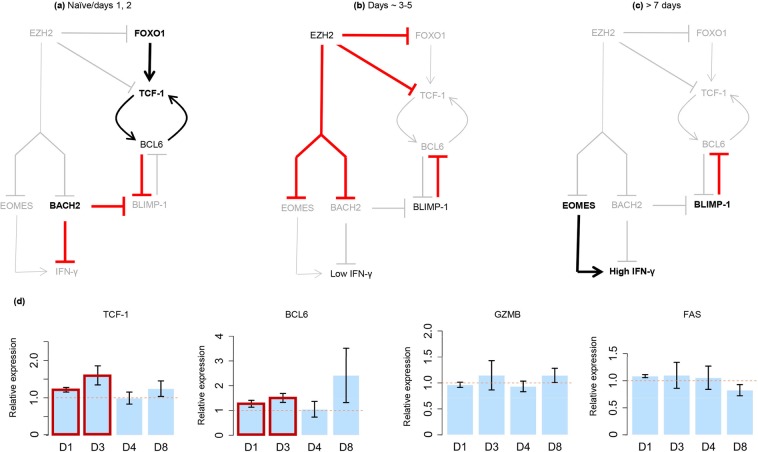Figure 7.
Prediction of the effect of EZH2 inhibition on T cell exhaustion (TCE). The networks in panels (a–c) show 3 distinct states that the primary targets of EZH2/PRC2 adopt following TCR stimulation, and reveal that EZH2 has pro-PP effects at all times. (a) Although EZH2 transcription peaks at about 1 day post-stimulation, its repressive effects (via PRC2) are not apparent until around Day 3 post-infection. PRC2 is not active in naïve CD8+ cells, or during the earliest days post-stimulation. During this time, FOXO1 drives TCF-1 (pro-PP state) expression, and BACH2 represses the pro-EE state gene BLIMP-1. (b) At around 3–5 days post-infection, EZH2/PRC2 inhibit FOXO1, BACH2, and TCF-1, allowing the expression of the pro-EE gene BLIMP-1. In turn, BLIMP-1 represses the pro-PP gene BCL6. Concurrent with these events, EZH2 inhibition blocks early expression of the EE gene EOMES. Thus, inhibition of EZH2 during this period will block/delay the onset of the EE state. (c) EZH2 transcription returns to basal levels by about 7 days post-infection, allowing EOMES to become activated and drive high (EE state) IFN-γ expression. (d) Experimental evidence supporting the pro-PP predicted effect of EZH2 inhibition in human peripheral blood T cells (average of 3 donors and 3 technical replicates per donor). Shown are the relative mRNA levels (treatment relative to no-treatment) of the pro-PP genes TCF-1 and BCL6, and the EE marker genes GZMB and FAS as measured by RT qPCR at days 1, 3, 4, and 8 post-infection (D1 to D8). As predicted, both TCF-1 and BCL6 are up-regulated in the early days post-infection (red boxes), while GZMB and FAS expression levels show no significant change. Error bars mark ±1 standard error.

